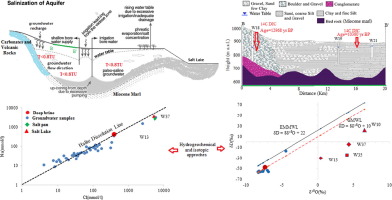当前位置:
X-MOL 学术
›
J. Hydrol.
›
论文详情
Our official English website, www.x-mol.net, welcomes your
feedback! (Note: you will need to create a separate account there.)
Delineating the Source and Mechanism of Groundwater Salinization in Crucial Declining Aquifer Using Multi- Chemo-Isotopes Approaches
Journal of Hydrology ( IF 5.9 ) Pub Date : 2020-07-01 , DOI: 10.1016/j.jhydrol.2020.124877 Mohammad Mirzavand , Hoda Ghasemieh , Seyyed Javad Sadatinejad , Rahim Bagheri
Journal of Hydrology ( IF 5.9 ) Pub Date : 2020-07-01 , DOI: 10.1016/j.jhydrol.2020.124877 Mohammad Mirzavand , Hoda Ghasemieh , Seyyed Javad Sadatinejad , Rahim Bagheri

|
Abstract Hydrogeochemical and multi-isotopic (18O, 2H, 3H, 13C, and 14C) approaches were applied accompanied with hydrogeological investigations to determine the origin and mechanism of groundwater salinization in Kashan Plain Aquifer (KPA). Evolution of hydrogeochemical facies in KPA is Ca-HCO3 (19.04%), Mix Ca-Cl, and Ca-Cl (9.52%), Mix Na-Cl, and Na-Cl (72.26%) based on the HFE-M. The isotopic composition of δ2H and δ18O varies from −8.38 to 6.48‰ with average of −4.49‰ for δ18O and −57.09 to 22.68‰ with average of −40.28‰ for δ2H. The fresh and saline groundwater samples were plotted near the GMWL, with a minor shift towards more enriched values, indicating that the present meteoric water is the main origin of groundwater in the study area. Intrusion from salt lake and saltpan was rejected by ionic ratios and stable isotopes approaches. Further, geophysical investigations ruled out contributions from the Nasr Abad salt dome, as it is buried at about 480 m depth underneath the KPA. In addition, the radioisotopes results (3H, and 14C) showed that the KPA groundwaters comprise of modern meteoric waters mixed with deep paleo-brine waters (10000 to 21000 yr BP). Further, the Na/Cl, I/Cl, Cl/Br, and Li/Cl/Br/Cl ratios and 2H and 18O data showed that, most probable source of salinity for this deep paleo- brine water is halite dissolution in Miocene Marl and URFs formation in the bedrock of KPA. The mixing ratio calculated by chloride concentration showed about 60% mixing between deep brine and groundwater samples. Consequently, the source of salinity in KPA groundwater is dissolution of halite and gypsum in deep paleo-brine which is likely upconing and mixing with fresh groundwaters during heavy pumping.
中文翻译:

使用多化学同位素方法描绘关键下降含水层中地下水盐渍化的来源和机制
摘要 应用水文地球化学和多同位素(18O、2H、3H、13C 和 14C)方法以及水文地质调查来确定喀山平原含水层(KPA)地下水盐渍化的起源和机制。KPA 中水文地球化学相的演化是基于 HFE-M 的 Ca-HCO3 (19.04%)、混合 Ca-Cl 和 Ca-Cl (9.52%)、混合 Na-Cl 和 Na-Cl (72.26%)。δ2H和δ18O的同位素组成从-8.38~6.48‰变化,δ18O平均为-4.49‰,δ2H平均为-57.09~22.68‰,平均为-40.28‰。淡水和咸水地下水样本绘制在 GMWL 附近,向更富集的值略有变化,表明目前的大气水是研究区地下水的主要来源。离子比和稳定同位素方法拒绝了来自盐湖和盐田的入侵。此外,地球物理调查排除了 Nasr Abad 盐丘的贡献,因为它被埋在 KPA 下方约 480 m 的深度。此外,放射性同位素结果(3H 和 14C)表明 KPA 地下水由现代大气水与深古盐水(10000 至 21000 年 BP)混合组成。此外,Na/Cl、I/Cl、Cl/Br 和 Li/Cl/Br/Cl 比率以及 2H 和 18O 数据表明,这种深层古盐水最可能的盐分来源是中新世泥岩中的岩盐溶解KPA 基岩中的 URFs 形成。由氯化物浓度计算的混合比表明深层盐水和地下水样品之间的混合率约为 60%。最后,
更新日期:2020-07-01
中文翻译:

使用多化学同位素方法描绘关键下降含水层中地下水盐渍化的来源和机制
摘要 应用水文地球化学和多同位素(18O、2H、3H、13C 和 14C)方法以及水文地质调查来确定喀山平原含水层(KPA)地下水盐渍化的起源和机制。KPA 中水文地球化学相的演化是基于 HFE-M 的 Ca-HCO3 (19.04%)、混合 Ca-Cl 和 Ca-Cl (9.52%)、混合 Na-Cl 和 Na-Cl (72.26%)。δ2H和δ18O的同位素组成从-8.38~6.48‰变化,δ18O平均为-4.49‰,δ2H平均为-57.09~22.68‰,平均为-40.28‰。淡水和咸水地下水样本绘制在 GMWL 附近,向更富集的值略有变化,表明目前的大气水是研究区地下水的主要来源。离子比和稳定同位素方法拒绝了来自盐湖和盐田的入侵。此外,地球物理调查排除了 Nasr Abad 盐丘的贡献,因为它被埋在 KPA 下方约 480 m 的深度。此外,放射性同位素结果(3H 和 14C)表明 KPA 地下水由现代大气水与深古盐水(10000 至 21000 年 BP)混合组成。此外,Na/Cl、I/Cl、Cl/Br 和 Li/Cl/Br/Cl 比率以及 2H 和 18O 数据表明,这种深层古盐水最可能的盐分来源是中新世泥岩中的岩盐溶解KPA 基岩中的 URFs 形成。由氯化物浓度计算的混合比表明深层盐水和地下水样品之间的混合率约为 60%。最后,











































 京公网安备 11010802027423号
京公网安备 11010802027423号